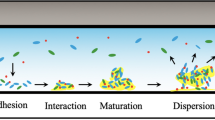Abstract
As the success of this two-issue special section of the Journal of Industrial Microbiology attests, the study of microbial biofilms is truly burgeoning as the uniqueness and the importance of this mode of growth is increasingly recognized. Because of its universality the biofilm concept impacts virtually all of the subdivisions of Microbiology (including Medical, Dental, Agricultural, Industrial and Environmental) and these two issues incorporate contributions from authors in all of these disciplines. Some time ago we reasoned that bacteria cannot possibly be aware (sic) of their precise location, in terms of this spectrum of anthrocentric subspecialties, and that their behavior must be dictated by a standard set of phenotypic responses to environmental conditions in what must seem to them (sic) to be a continuum of very similar aquatic ecosystems. In this overview I will, therefore, stress the common features of microbial biofilms that we should bear in mind as we use this simple universal concept to seek to understand bacterial behavior in literally hundreds of aquatic ecosystems traditionally studied by dozens of subspecies of microbiologists reared in sharply different scientific and academic conventions.
Similar content being viewed by others
References
Boyd A and AM Chakrabarty. 1994. Role of alginate lyase in cell detachment ofPseudomonas aeruginosa. Appl Environ Microbiol 60: 2355–2359.
Brown MRW, PJ Collier and P Gilbert. 1990. Influence of growth rate on susceptibility to antimicrobial agents: modifications of the cell envelope and batch and continuous culture studies. Antimicrob Agents & Chemother 34: 1613–1623.
Costerton JW, K-J Cheng, GG Geesey, TI Ladd, NC Nickel et al.. 1987. Bacterial biofilms in nature and disease. Ann Rev Microbiol 41: 435–464.
Costerton JW, Z Lewandowski, D DeBeer, DE Caldwell, DR Korber and GA James. 1994. Biofilms: the customized micronich. J Bacteriol 176: 2137–2142.
Costerton JW, Z Lewandowski, DE Caldwell, DR Korber and HM Lappin-Scott. 1995. Microbiol biofilms. Ann Rev Microbiol (in press).
Cunningham AB. 1989. Hydrodynamics and solute transport at the fluid-biofilm interface. In: Structure and Function of Biofilms (Characklis WG and PA Wilderer, eds), pp 19–31, J Wiley & Sons, New York.
Davies DG, AM Chakrabarty and GG Geesey. 1993. Exopolysaccharide production in biofilms: substratum activation of alginate gene expression byPseudomonas aeruginosa. Appl Environ Microbiol 59: 1181–1186.
DeBeer D, P Stoodley, FL Roe and Z Lewandowski. 1994a. Effects of biofilm structures on oxygen distribution and mass transport. Biotech Bioeng 43: 1131–1138.
DeBeer D, P Stoodley and Z Lewandowski. 1994b. Liquid flow in heterogeneous biofilms. Biotech Bioeng 44: 636–641.
Deretic V, MJ Schurr, JC Boucher and DW Martin. 1994. Conversion ofPseudomonas aeruginosa to mucoidy in cystic fibrosis: environmental stress and regulation of bacterial virulence by alternative sigma factors. J Bacteriol 176: 2773–2780.
Fletcher M and GI Loeb, 1979. Influence of substratum characteristics on the attachment of a marine pseudomonad to solid surfaces. Appl Environ Microbiol 37: 67–72.
Fuqua WC, SC Winans and EP Greenberg. 1994. Quorum sensing in bacteria: the luxR-luxl family of cell density-responsive transcriptional regulators. J Bacteriol 176: 269–275.
Gilbert P, PJ Collier and MRW Brown. 1990. Influence of growth rate on susceptibility to antimicrobial agents: biofilms, cell cycle, dormancy, and stringent response. Antimicrob Agents & Chemother 34: 1856–1868.
Grainger DW, C Salese, JN Herron and H Ringsdorf. 1992. Modelling membrane targeting: interaction and recognition of proteins with model biomembrane systems. J Controlled Release 19: 201–218.
Hoyle BD, LJ Williams and JW Costerton. 1993. Production of mucoid exopolysaccharide during development ofPseudomonas aeruginosa biofilms. Infect Immun 61: 777–780.
Kaiser D and R Losick. 1993. How and why bacteria talk to each other. Cell 73: 873–885.
Korber DR, JR Lawrence, HM Lappin-Scott and JW Costerton. 1995. The formation of microcolonies and functional consortia within biofilms. In: Bacterial Biofilms (Lappin-Scott HM and JW Costerton, eds), Cambridge University Press, Cambridge, UK (in press).
Kudo H and JW Costerton. 1987. Interactions betweenTreponema bryantii and cellulolytic bacteria in thein vitro degradation of straw cellulose. Can J Microbiol 33: 267–272.
Lappin-Scott HM and JW Costerton. 1995. Microbial Biofilms. Cambridge University Press, Cambridge, UK.
Lawrence JR, DR Korber, BD Hoyle, JW Costerton and DE Caldwell. 1991. Optical sectioning of microbial biofilms. J Bacteriol 173: 6558–6567.
Lewansowski Z, SA Altobelli and E Fukushima. 1993. NMR and microelectrode studies of hydrodynamics and kinetics in biofilms. Biotech Prog 9: 40–45.
Macleod FA, SR Guiot and JW Costerton. 1990. Layered structure of bacterial aggregates produced in an upflow anaerobic sludge bed and filter reactor. Appl Environ Microbiol 56: 1589–1607.
Martin DW, MJ Schurr, H Yu and V Deretic. 1994. Analysis of promoters controlled by the putative sigma factor algU regulating conversion to mucoidy inPseudomonas aeruginosa: relationship to sigmaE and stress response. J Bacteriol 176: 6688–6696.
Nichols WW, SW Dorrington, MPE Slack and HL Walmsley. 1988. Inhibition of tobramycin diffusion by binding to alginate. Antimicrob Agents & Chemother 32: 518–523.
Stoodley P, D DeBeer and Z Lewandowski. 1994. Liquid flow in biofilm systems. Appl Environ Microbiol 60: 2711–2716.
Zobell CE. 1943. The effect of solid surfaces upon bacterial activity. J Bacteriol 46: 39–56.




